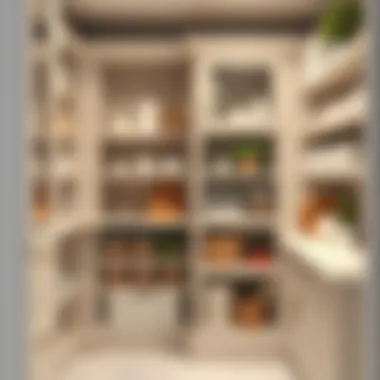Mastering Pantry Organization: A Comprehensive Guide


Intro
Every home is a canvas for creativity, and the kitchen pantry is no exception. A well-organized pantry doesn’t just unveil its contents; it elevates the entire culinary experience. How often have you rummaged through countless bags of flour, cans of beans, or forgotten snacks? The frustration of disorganization can dull even the sharpest cooking ambitions. That's where the art and science of pantry organization come into play. This guide goes beyond mere storage solutions, examining the strategies that cater to both aesthetic appeal and practical utility.
The need for organization permeates lifestyle choices today. Homeowners and enthusiasts alike are recognizing how clutter can hinder efficiency not just in the kitchen, but across daily routines. By categorizing your pantry items sensibly and adopting effective storage methods, you're opening doors to a smoother culinary journey. Whether it’s the simple pleasure of a straightforward recipe or the intricate dance of flavor in gourmet cuisine, a well-maintained pantry is your silent partner.
Furniture Styles and Trends
When considering the aesthetic aspect of a pantry, furniture styles come to the forefront.
Modern vs. Traditional: Understanding the Aesthetics
Today’s kitchen designs often balance modern minimalism with traditional charm. A modern pantry leans towards sleek lines, open shelving, and a clean, functional layout that emphasizes space and airiness. On the opposite end, traditional pantries value warmth with wood finishes, ornate shelving, and rich color palettes. Both styles reflect the preferences and lifestyle of the homeowner.
Modern designs often incorporate features like:
- Clear glass jars displaying contents
- Adjustable shelving systems for organization
- Hidden compartments that maximize functional space
In contrast, traditional aesthetics might emphasize:
- Wooden cabinetry with intricate carvings
- Vintage containers that tell a story
- A warm color scheme using earth tones to invite comfort.
Choosing a style is more than a matter of preference; it reflects personal habits in the kitchen. Consider how each style aligns with your cooking habits and accessibility needs.
Color and Material Trends: What's In and What's Out
When it comes to colors, bright whites and muted earth tones are dominating many modern kitchens while pastels complement the retro charm of traditional designs. Materials like stainless steel, and reclaimed wood are trending, providing durability while maintaining a stylish facade. Lighter colors can enhance a small pantry, creating an illusion of spaciousness. However, if you favor a cozy space, deep colors can add depth and warmth.
"Choosing the right colors and materials not only impacts the visual appeal but also enhances practicality in maintaining a clean and organized environment."
Maintenance and Care
To keep your pantry looking its best, understanding furniture care is essential. Just as the aesthetics of pantry organization matter, maintaining that organization is critical to longevity and cleanliness. Consider these tips:
Tips for Prolonging the Life of Your Furniture
- Regularly clean shelves to prevent dust buildup.
- Avoid exposing wood to excessive moisture, which can warp it over time.
DIY Repair Hacks for Common Furniture Issues
- For scratched wooden surfaces, mix equal parts of olive oil and vinegar to create a natural polish.
- If drawer slides become stiff, rub some wax on them for improved movement.
With a bit of care, your pantry can remain an organized oasis for many years to come.
This guide will further explore trends, essential principles, and bespoke organizational techniques tailored for every kitchen. Stay tuned as we delve deeper into making your pantry not just functional, but a delightful aspect of cooking life.
Understanding Pantry Organization
An organized pantry is more than just a neat space; it’s the backbone of an efficient kitchen. Imagine finding what you need without diggin’ through a maze of old cans or half-empty bags of flour. Let’s dive deep into why this matters.
The Importance of an Organized Pantry
Having an organized pantry holds several benefits that go beyond mere aesthetics. Firstly, it saves precious time during meal prep. When items are neatly arranged and grouped together, finding that elusive can of chickpeas or a favored spice becomes a breeze. Moreover, a well-structured pantry reduces stress. A cluttered space can lead to frustration, especially when you’re in a rush to whip up dinner.
An organized pantry also plays a significant role in minimizing food waste. When contents are visible and labeled, you’re more likely to utilize what you have, avoiding the scenario of discovering old, expired food buried in the back. It's a practical method for managing your grocery budget, as you'll have a clearer picture of what you truly need versus buying duplicates out of sight.
Lastly, a tidy pantry can inspire creativity. The act of organizing might reveal hidden treasures—like that unique spice blend from your last trip abroad. You might just find the motivation to try a new dish or experiment with different flavors.
"An organized pantry streamlines your culinary adventures, making every meal a joyous event rather than a scavenger hunt."
Common Challenges in Pantry Management
While the benefits of a well-organized pantry are clear, many face hurdles when tackling this task. One major challenge is the sheer volume of items. Over time, a pantry can overflow with various goods, some of which may be forgotten altogether. This overcrowding often leads to frustration and an overall sense of chaos.
Another issue is the tendency to accumulate expired products. Items can slip through the cracks, especially if they’re stored in opaque containers or not labeled properly. Consequently, food waste can soar, which is all the more frustrating given the hard-earned dollars spent on groceries.
Additionally, space constraints can pose significant issues. Not every kitchen is blessed with an expansive pantry; many homes must make do with smaller spaces. This challenge often requires creative solutions to ensure everything has its place without feeling cramped.
Finally, personal habits also contribute to the difficulty of maintaining organization. Without a clear system in place or a dedicated effort to keep things in order, even the best-organized pantry can quickly revert to chaos.
Addressing these challenges involves a mix of strategy, commitment, and a willingness to adapt. By understanding both the importance of organization and the common pitfalls, homeowners can set realistic goals and create a functional storage environment.
Assessing Your Current Pantry Setup
Assessing your current pantry setup is a crucial step on the path to crafting an organized and functional space. Before diving headfirst into decluttering and reorganizing, it’s important to fully grasp what’s currently residing in your pantry. This assessment allows you to identify what you need, what you don’t, and what might require a little tweak to enhance your pantry efficiency. By evaluating what you have, you lay down a solid foundation for any future organization efforts.
Taking stock not only sheds light on the essentials but also highlights the culprits of clutter. An often overlooked aspect is that by understanding your pantry's composition, you can tailor your organization strategies to fit your unique habits and preferences. This step draws a clear picture of your consumption patterns, and can guide you in making mindful shopping choices in the future. Knowing what’s in there can help you avoid the same old predicament of digging through a chaotic heap just to find that can of chickpeas that’s lingering from last year.
Taking Stock of What You Have
The first step in assessing your pantry is to take a good, hard look at what’s on your shelves. This means emptying the pantry entirely, if possible, and laying everything out. As you pull out each item, ask yourself a few important questions:
- Is this something I use regularly? Likely keeping it handy in the pantry is a must.
- Does it still serve a purpose? Sometimes we hang onto items 'just in case'—be honest with yourself about whether they'll actually be used.
- Is it a duplicate? All too often, we find multiple boxes of the same snacks or multiple cans of the same ingredient.


Once you have a visual inventory, consider writing it down or using an app to keep track. A comprehensive list can serve as an effective reference for future meal planning and grocery shopping, ensuring that you’re not only mindful of what you have but also what you truly need to buy.
Your pantry should reflect your cooking habits—not clutter up your space with items that pile dust.
Identifying Expired or Unwanted Items
Next on the agenda is identifying any expired or unwanted items. We all have that sneaky bag of expired quinoa or the half-used jar of specialty olives we picked up during a sale. Going through the contents meticulously helps eliminate wasted space and ensures everything on your shelf has a potential purpose.
While checking expiration dates, take note of:
- Items that are well past their expiry date: Toss these out without a second thought.
- Almost-empty packages: If it's been gathering dust for a while, it might not be worth keeping.
- Food that has unfavorable odors or textures: If it smells off or has changed color, it’s safer to say goodbye.
It’s wise to prioritize food safety and generally to eliminate potentially harmful items. The goal is to create a space that not only serves you better but one you can feel proud of. In the end, a refreshed pantry will lead to a more enjoyable cooking experience and a healthier approach to meal prep, making it a win-win for everyone.
By honing in on these two steps in your pantry assessment, you can transform chaos into clarity, allowing for a fresh start and setting the stage for the next steps in this organizational journey.
Creating a Pantry Organization Plan
Creating a pantry organization plan is essential for transforming a cluttered space into a streamlined haven of culinary efficiency. It’s not just about making things look nice; it’s about establishing a system that works for you and your household’s routines. When you set out to develop a plan, you're not only thinking about how to store items but also how to optimize your time in the kitchen. A well-organized pantry directly contributes to meal prep efficiency, reduces waste, and ultimately makes cooking more enjoyable.
When crafting your plan, consider factors such as your cooking habits, the size of your pantry, and even your personal style. For instance, how often do you cook? Do you prefer quick meals or are you fond of elaborate cooking sessions? Understanding these preferences helps establish a plan that tailors to your needs.
Moreover, take into account the types of foods you store. If you buy in bulk, you might need a different arrangement than someone who prefers fresh produce. By aligning your pantry organization with how you actually use your space, you can ensure it’s easy and efficient.
Now, let’s delve into specific methods for carving out that perfect plan that will suit your pantry's unique needs.
Setting Goals for Your Pantry
Every successful organization effort begins with clear goals. Ask yourself what you hope to achieve through this pantry overhaul. Here are several goals you may want to consider:
- Accessibility: Aim to have frequently used items within arm's reach.
- Reduction of Food Waste: Establish a flow that helps you utilize older items first.
- Aesthetic Appeal: Perhaps you want a visually pleasing space that inspires you to cook more.
- Space Maximization: Remember to utilize every nook and cranny effectively.
Each of these goals can help focus your efforts and ensure that you are steering towards a satisfying result.
Choosing an Organization Style
Selecting the right organization style is like choosing the right dish for dinner—getting it right makes all the difference. Your approach can be minimalist, functional, or aesthetic-centric. Here’s a closer look at each option:
Minimalist Approach
The minimalist approach thrives on simplicity. It focuses on keeping only the essentials in your pantry, fostering a clutter-free environment. The key characteristic here is to declutter ruthlessly. This method appeals to those looking to streamline their lives, creating a sense of calm in your kitchen.
One unique feature of minimalism is that it minimizes decision fatigue; when you have fewer items, it’s easier to make choices. However, be aware that it can be challenging if you often use numerous ingredients or have a penchant for specialty items. The balance lies in keeping enough to cook your desired meals without overwhelming yourself with choices.
Function-Based Organization
With a function-based organization style, the focus is on grouping foods according to their usage. For instance, all baking supplies go in one section, while snacking items occupy another. The goal is efficiency. This method is particularly beneficial for those who cook often and enjoy being systematic about their recipes.
A significant advantage of this style is that it offers clarity—no need to rummage through disparate items. However, it might limit your creative cooking spontaneity if you're used to grabbing items without a clear structure.
Aesthetic-Centric Organization
Aesthetic-centric organization prioritizes visual appeal. This approach considers how beautiful and inviting your pantry looks. The key characteristic here involves choosing storage containers that are both practical and pleasing to the eye. This style is ideal for those who derive joy from a visually stunning kitchen.
One unique feature of this approach is that it invites creativity. You might display spices in beautiful jars or stack containers in a way that catches the eye. However, one downside could be that functionality might take a backseat if items are not easily accessible. Balancing beauty with usability is fundamental in ensuring this method works without a hitch.
In closing, pinpointing your organizational style and setting clear goals can fundamentally change how you interact with your pantry. As you reflect on these elements, consider keeping resources like www.britannica.com and www.reddit.com handy for additional insights on pantry strategies.
Essential Tools for Pantry Organization
An organized pantry is not just a luxury but a necessity for efficient cooking and storage. Having the right tools can make a world of difference in achieving and maintaining this order. Here, we'll explore the essential items that can turn a chaotic pantry into a well-oiled culinary machine. With these tools, not only will you save time while cooking, but you'll also find it much easier to keep track of your ingredients.
Storage Containers and Bins
Storage containers are the unsung heroes of pantry organization. By investing in a mix of durable containers, you create a cohesive look that instantly elevates the space. Not only do they keep ingredients fresh, but they also minimize clutter.
- Clear vs. Opaque: Choose clear containers to identify contents quickly, while opaque ones can be great for less-used items.
- Sealing Mechanisms: Ensure they have airtight seals to prevent moisture and pests from invading your pantry. Common materials include glass, plastic, and stainless steel. Each has its pros and cons regarding durability and maintenance.
Bins also play a key role. They can help you group similar items together, like snacks or baking supplies. Large bins can serve as catch-alls for things like produce that don’t need refrigeration. This approach simplifies the process of both storing and retrieving goods, making your pantry feel less overwhelming.
Labels and Markers
You might not think about them often, but labels are crucial in keeping your pantry organized. They remove any guesswork, allowing you to know exactly what’s inside your containers or bins at a mere glance.
- Types of Labels: You can choose from paper labels, sticker labels, or even chalkboard labels that can be rewritten as your ingredients change.
- DIY vs. Store-bought: A DIY approach can add a personal touch, while store-bought options may offer a polished, professional look.
- Font and Size: Clear, legible fonts in an adequately large size ensure that anyone in the household can easily read what’s inside.
Using labels not only helps in finding things faster but also brings order to the chaotic mix of groceries and cooking essentials, ensuring that everything has its place.
Tools for Measuring and Sorting
To prevent pantry puzzles, tools for measuring and sorting are vital. These help in maintaining an organized state and ensuring that you are baking and cooking with precision.
- Measuring Cups and Spoons: Invest in a set that is both accurate and easy to read. This keeps your cooking consistent.
- Digital Scale: A digital kitchen scale can be invaluable, particularly for baking. It allows for precise measurement of ingredients, ensuring you don’t fall short on that cake or bread.
- Sorting Baskets: Integrate sorting baskets within your pantry for easy access to commonly used ingredients—like flour and sugar, or frequently used canned goods.One can also use drawer dividers to separate smaller items, making sure that your pantry maintains an organized structure.


Proper organization begins and ends with the right tools.
By having the essential tools at your disposal, you are not just organizing your pantry—you're investing in a smoother, more pleasurable cooking experience.
Implementing Effective Organization Techniques
Implementing effective organization techniques is at the heart of transforming a chaotic pantry into a functional haven. This process goes beyond mere aesthetics; it touches on efficiency, accessibility, and prolonging the shelf life of your pantry items. A well-organized space means you spend less time searching for that misplaced can of beans or the third of the three bags of flour you never knew you had. By categorizing your goods, maximizing vertical space, and creating designated zones, you can not only simplify your cooking process but also enjoy a sense of pride in your pantry.
Categorizing Your Pantry Goods
Dry Goods
Dry goods, such as pasta, rice, and grains, are staples in most households. The crucial aspect of dry goods organizational technique lies in their versatility. They are non-perishable, easy to store, and conducive for long-term usage, making them a popular choice among those looking to build efficiency in their pantry.
The primary characteristic of dry goods is their typically long shelf life, often lasting months or even years under proper conditions. This longevity allows you to buy in bulk, often leading to savings on groceries over time. Additionally, when organized properly, dry goods can be visually appealing. Using clear containers helps in recognizing stock levels without digging through a cluttered shelf.
However, while bulk buying creates opportunities for savings, there is a downside. If not used promptly, these items can lose their flavor or nutritional value. Proper labeling with dates ensures that older stock is used first, and freshness is maintained.
Canned Items
Canned items offer another dimension to pantry management. They cater to convenience, as they often come pre-cooked or require minimal preparation. The key trait of canned items is their quick accessibility and favorable storage life, allowing them to be a beneficial component of any pantry.
An exceptional attribute of canned goods is the variety they bring to your meals — from vegetables to beans and even proteins like fish. This variety increases the flexibility within meal plans and encourages diverse nutrition. However, the downside is their heavy reliance on preservatives, which some individuals prefer to avoid.
Utilizing a rotation system, known as 'first in, first out' (FIFO), when organizing canned goods helps in preventing waste, ensuring older cans are used before newer ones.
Snacks and Treats
Snacks and treats play a vital role in any household, especially for families with children. The primary aspect here encompasses convenience and quick access, with a plethora of options ranging from trail mix to cookies. Their characteristic feature is that they should be kept handy to satisfy cravings at a moment's notice, promoting a more enjoyable kitchen experience.
One unique feature of snacks is the emphasis they place on portion control. Using bins or baskets allows you to separate sweet treats from healthier options, making it easier to choose wisely when hunger strikes. However, be cautious — unregulated access can lead to overeating, especially if high-calorie options take center stage in an easily accessible spot.
Baking Supplies
Baking supplies, often considered essential for home bakers and pastry chefs alike, comprise a wide range of items like flour, sugars, spices, and leavening agents. The organization of baking supplies upholds the importance of having readily available materials for when inspiration sparks a culinary creation.
A key characteristic of this category is the need for precision. Clear labeling and categorized storage are vital for ensuring that you have what you need. Using airtight containers protects these ingredients from moisture and air, which can spoil them. Additionally, baking supplies can often have shorter shelf lives, particularly items like baking powder that can lose potency over time.
With that said, an organized baking zone helps ensure that you can whip up a cake or batch of cookies anytime without sifting through a jumbled mess.
Vertical Space Utilization
Maximizing vertical space is a game-changer when it comes to pantry organization. By utilizing racks, shelves, and hooks, you can dramatically increase your storage capacity without taking up additional floor space. Tall shelves can be strategically used to store infrequently used items at the back and more frequently accessed ones at eye level.
This technique not only utilizes every nook and cranny but also creates an interesting dynamic in your pantry layout. Ensure that heavier items are placed lower to avoid accidents, while lighter containers can float to the top. Using tiered organizers can also provide visibility, allowing you to spot items quickly.
Creating Zones within Your Pantry
Cooking Zone
Establishing a cooking zone means creating a dedicated area for all items necessary for meal preparation. This includes basic ingredients like oils, spices, and essential cooking tools. The organized layout encourages efficiency during the often-hectic cooking process.
This area’s importance lies in its ability to reduce the time and effort spent in searching for what you need. By having everything in one spot, it allows for smoother meal prep sessions, enhancing your overall cooking experience.
Snacking Zone
A snacking zone is equally important, especially for households with children or those who entertain guests often. This designated area not only cultivates ease of access but also paves the way to healthier snacking habits, by having wholesome options front and center.
While it may seem trivial, organizing a snacking zone can transform mindless munching into mindful eating, promoting better choices and preventing overindulging on unhealthy treats.
Baking Zone
Similar to the cooking zone, the baking zone serves its purpose for those who enjoy crafting desserts or baked goods. This area must be organized just as meticulously, with all necessary items like flour and sugar conveniently accessible. An efficient layout saves both time and mess during those spontaneous baking nights.
The beauty of creating these zones is to maintain order, ensuring that your pantry works for you rather than against you. A well-organized pantry with distinct zones not only heightens the overall aesthetics but contributes to a smoother culinary journey every time you step into your kitchen.
An organized pantry is not just a luxury; it’s a stepping stone to culinary creativity and household harmony.
Maintaining Your Organized Pantry
An organized pantry is not just a luxury; it's a necessity for streamlining your day-to-day culinary endeavors. Maintaining the order you've worked so hard to achieve can make the difference between a functional kitchen and one filled with frustration. When everything has its designated spot, cooking becomes effortless, and grocery shopping transitions from chaotic to efficient.
Regular Decluttering Routines
One of the keystones in maintaining your organized pantry is the practice of regular decluttering. This doesn’t mean waiting until your pantry begins to resemble a disaster zone. Instead, aim for a proactive approach. Schedule a routine—maybe monthly or bi-monthly, depending on your pantry's traffic. Start by pulling out items that are past their prime, or, goodness forbid, lurking in the shadows for too long.
Keep an eye out for things that no longer fit your lifestyle or dietary choices. If you bought that gluten-free flour but have never used it, it might be time to part ways. Here’s a simple list to guide your decluttering:
- Check expiration dates
- Evaluate your eating habits
- Remove items that bring you no joy or utility
By doing this, you not only save space but also make room for fresh ingredients that might inspire new dishes. Turning a blind eye to outdated products just complicates things and can lead to unnecessary waste, which ties into other overarching themes in your pantry management journey.
Adapting to New Pantry Needs


It's crucial to recognize that all pantries evolve over time. Whether you're embracing a new dietary lifestyle, welcoming additional family members, or simply finding new cooking preferences, being able to adapt your inventory is paramount.
For instance, if you've decided to go plant-based, your once diverse lineup of condiments might need a strict culling. Likewise, finding out your kids can’t stop munching on snacks means that snack organization may become a priority over baking ingredients.
Keep your pantry fluid. Here's a few considerations to keep in mind as your needs change:
- Assess regularly: Every season, take stock of your pantry and see if your eating habits match what’s on the shelves.
- Be open to new storage solutions: If your pantry starts to feel cramped, consider adding shelving or using vertical space more creatively. Baskets or drawer inserts can also maximize your existing setup.
- Change your categorization: If one area of your pantry becomes a dead zone, don't hesitate to reassign those contents to a more useful nook.
"An organized pantry is a happy pantry. When in doubt, make room for what matters."
By keeping a vigilant eye on both your pantry's contents and your culinary habits, you ensure that your space remains a functional hub that supports your needs. Embracing these elements will ultimately lead you to a pantry that’s not just tidy, but intuitively aligned with your lifestyle.
Troubleshooting Common Pantry Issues
An organized pantry is not just a dream; it’s a crucial aspect for anyone who spends a good amount of time in the kitchen. However, despite our best intentions, issues can arise that throw a wrench in our plans. Troubleshooting common pantry issues is vital because it helps to maintain the functionality of your space. Being aware of common hurdles, such as overcrowding and food waste, can provide the necessary insights to sustain a well-organized area. Recognizing the problems early on allows for tailored solutions that drive efficiency in your everyday culinary practices.
Dealing with Overcrowding
Overcrowding can feel like an insurmountable obstacle. When your pantry resembles a game of Tetris, finding ingredients becomes a herculean task. An overflowing pantry affects not just aesthetics but also functionality. Items get lost, and expiration dates are missed, creating chaos when you're in a rush to whip up dinner.
To tackle this issue, start by re-evaluating what really deserves its spot in your pantry. Here are some practical steps to manage overcrowding effectively:
- Conduct a Mini-Investigation: Dive into your pantry with a fresh perspective. Identify duplicate items and those long-forgotten, nestled in the back. Toss what you no longer need or use.
- Group by Categories: Instead of a free-for-all, sort items into categories such as baking supplies, snacks, and canned goods. This makes it easier to identify what you have and what might be taking up unnecessary space.
- Utilize Verticality: Consider adding extra shelves or tiered storage that takes advantage of vertical space. Every inch counts, especially if your pantry isn't vast.
- Invest in Clear Containers: These not only keep food fresh but allow you to see what you have at a glance. Sometimes, it's all about visibility.
With these steps, you can draw a clear line between what is essential and what is just taking space. Remember, an organized pantry reflects clarity in meal planning and reduces the stress that comes with cooking.
Strategies for Preventing Waste
Preventing waste in the pantry is akin to finding buried treasure; it’s about recognizing value in your food expenditures. Keeping track of what you have and utilizing it before it goes bad is crucial for maintaining both your wallet and your sanity. Here are some methods that can help:
- First In, First Out: Implement this principle by placing older items at the front and newer ones at the back. This logically ensures items are used in the order of their purchase and keeps freshness in check.
- Plan Your Meals Around Pantry Staples: When creating meal plans, take inventory of your pantry staples. Integrate those ingredients into your weekly meals rather than purchasing more on a whim.
Your wallet will appreciate it. - Date Your Items: Write purchase dates on containers or cans. A little reminder can go a long way in aiding your memory about what needs to be consumed sooner rather than later.
- Embrace Freezing: If you sense that something might expire, consider freezing it. This step can save ingredients and make meal prep easier.
By implementing these strategies, you can reduce waste effectively. A little foresight turns your pantry from a potential source of guilt into a reservoir of resources for delicious meals.
“An organized pantry isn't just about tidiness; it's about laying the groundwork for culinary creativity.”
In summary, understanding how to troubleshoot common pantry issues can enhance your cooking experience. A well-organized pantry not only saves time but also enriches your culinary endeavors while fostering a sustainable approach to food management.
Additional Resources:
- Food Safety and Inspection Service
- Recycling and Sustainable Practices
- National Resource Defense Council – Food Waste
- Wikipedia – Food Storage
Embracing Sustainable Pantry Practices
In the modern age, where the conversation around sustainable living has become increasingly pivotal, embracing sustainable pantry practices is not just a trend but a necessity. It aligns with global efforts to reduce environmental impact while also enhancing the functionality and effectiveness of our kitchens. By adopting eco-friendly storage options and employing strategies to minimize food waste, homeowners and enthusiasts alike contribute to a healthier planet while optimizing their pantry space. The benefits are manifold: saving money, reducing clutter, and fostering a sense of responsibility towards our resources.
Choosing Eco-Friendly Storage Options
When it comes to selecting storage options, the choices matter more than one might think. Regular plastic containers, while convenient, often contribute to long-lasting waste in landfills. In contrast, eco-friendly storage alternatives can play a significant role in sustainability. Consider opting for glass jars or bins made from recycled materials. They do not only look appealing but also aid in keeping food fresher by providing a proper airtight seal. Moreover, using cloth bags or dishtowels as wrappings for certain items can dramatically decrease reliance on single-use plastic.
Here are a few eco-friendly storage ideas to keep in mind:
- Recycled Glass Jars: Perfect for storing dry goods like grains or legumes.
- Bamboo Containers: Naturally antibacterial and biodegradable, they contribute to a healthier environment.
- Fabric Produce Bags: These reduce the amount of plastic used in grocery shopping and are washable for reuse.
By investing in sustainable storage options, you not only create an organized pantry but also align your habits with a more environmentally-conscious lifestyle.
Reducing Food Waste through Smart Organization
Food waste is an issue that plagues many households. Smart organization can mitigate this problem significantly. Utilizing clear storage containers helps to keep visibility high, reminding you of what you have at hand. The principles of FIFO (First In, First Out) can significantly reduce food spoilage. Placing older items at the front and newer items at the back ensures that you’re consuming perishables in a timely manner.
Adapting practices such as meal planning or batch cooking can further reduce food waste. Here are a few techniques to consider while organizing:
- Labeling: Use labels on containers to indicate date of purchase or expiration.
- Create a Use-First Shelf: Dedicate a space in your pantry for items that are nearing expiration.
- Embrace Imperfect Produce: Incorporating less than perfect fruit or vegetables into your meals not only reduces waste but also encourages creativity in cooking.
By combining sustainable storage solutions with smart organization techniques, you nurture a pantry that serves not just your needs, but also those of the environment.
"An organized pantry is not just a feast for the eyes; it is a commitment to mindful consumption."
Engaging in sustainable practices in the pantry is a step towards greater environmental stewardship. As more homeowners and DIY enthusiasts embrace these changes, it becomes clearer that the path to sustainability begins not with grand gestures, but with thoughtful, everyday decisions.
End
In this article, we have meticulously explored the multifaceted domain of pantry organization. The conclusion here serves as not just a wrap-up, but as an affirmation of the significance inherent to maintaining an efficiently organized pantry. The essence of pantry optimization extends beyond mere aesthetics; it taps into the very heartbeat of a functional kitchen, enhancing both meal preparation and culinary creativity.
One of the primary benefits of an organized pantry is time-saving. When everything is in its rightful place, individuals can quickly locate what they need, reducing the often frustrating hunt for ingredients. This organization naturally fosters a smoother cooking process. Moreover, it encourages smarter shopping habits. A well-ordered pantry reveals what is available and what needs replenishing, preventing unnecessary purchases and ultimately leading to a more efficient grocery budget.
When considering pantry organization, it’s crucial to pay heed to individual circumstances. What works for one household might not suit another. Personal lifestyle, dietary needs, and even spatial constraints should influence the approach taken. This article emphasizes various organizational styles from minimalist to functional, thereby allowing for tailored solutions that resonate with the unique characteristics of each reader's household.
"An organized pantry reflects well-organized thoughts, leading to successful culinary endeavors."
Additionally, the sustainability aspect cannot be overlooked. Incorporating eco-friendly practices not only benefits the environment but also aligns with a growing consumer awareness. Smart storage solutions that reduce food waste are pivotal in today's world; they promote responsibility and mindfulness in food consumption.
In a nutshell, the organized pantry becomes more than just a storage space. It transforms into a domain that supports creativity, financial prudence, and sustainability. Thus, as we conclude our journey through the nuances of pantry organization, it’s clear that each step taken towards optimizing this essential part of the home translates into significant benefits that extend far beyond its physical confines. The next time someone steps into their pantry, it should be with pride and a sense of accomplishment, knowing they have mastered the art of organization for a richer culinary experience.
Final Thoughts on Pantry Optimization
The practice of pantry optimization is, at its core, about creating a functional and peaceful space where culinary aspirations can flourish. As we have discussed, the path to an organized pantry is not linear; it invites exploration, creativity, and personal adaptation. Each method discussed, from creating designated zones to using labels effectively, builds upon the overarching goal of efficiency.
Consider the following key takeaways:
- Adaptability is vital: Your pantry should grow and evolve with your needs. Incorporate changes whenever you notice inconsistencies or challenges arising.
- Regular review is necessary: Treat your pantry as a living system that requires periodic check-ups to maintain its functionality and efficiency.
- Cultivate a mindful approach to purchasing: Prioritize awareness in your shopping habits to only procure what you will use, ensuring minimal waste.
Every homeowner, designer, and DIYer has the opportunity to create a pantry that not only meets their storage needs but also stands as a testament to their cooking style and philosophy. Whether you undertake a complete overhaul or simply make incremental improvements, the pursuit of an optimized pantry is an admirable endeavor that yields richer and more enjoyable kitchen experiences.















